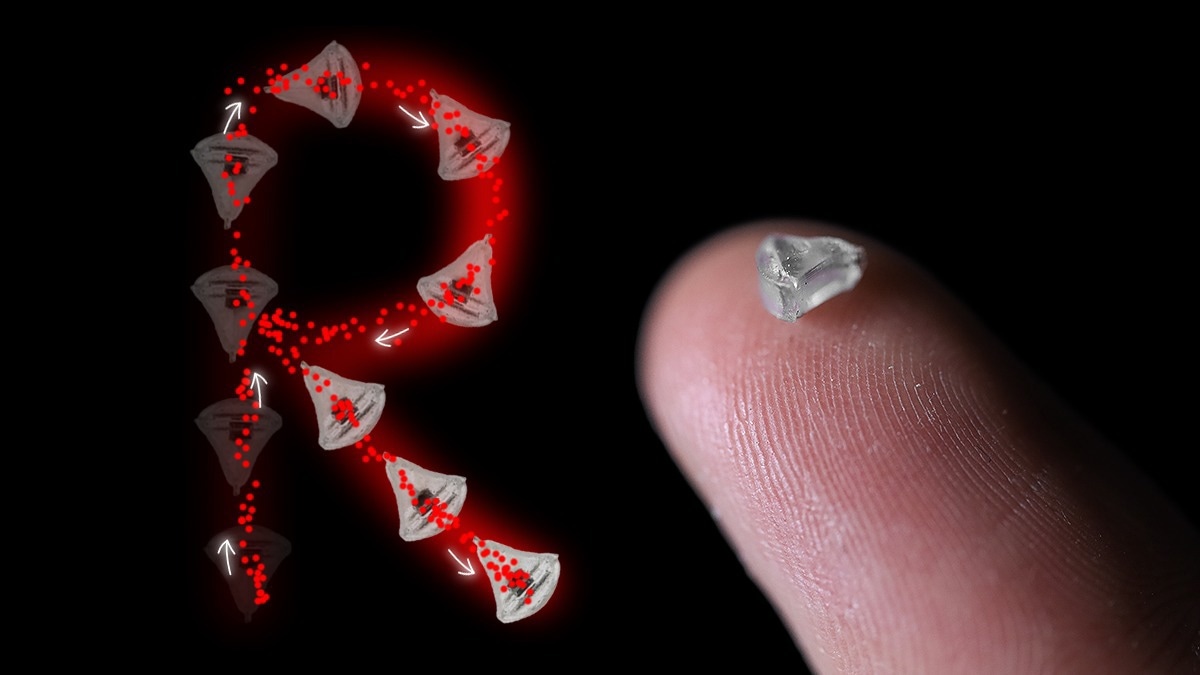Reviewed by Lexie CornerApr 3 2024
In the future of medicine, miniature robots are envisioned to autonomously navigate through tissue, while medical instruments will indicate their position within the body during surgical procedures. Both applications necessitate precise real-time localization and control by doctors.
 Miniature robot with built-in SMOL tracker, the built-in magnet is only 1 mm in size; left: R-shaped movement path of a SMOL-controlled miniature robot. Image Credit: ©Qiu/DKFZ
Miniature robot with built-in SMOL tracker, the built-in magnet is only 1 mm in size; left: R-shaped movement path of a SMOL-controlled miniature robot. Image Credit: ©Qiu/DKFZ
However, there has been no suitable method for achieving this; that is, until now. Scientists from the German Cancer Research Center (DKFZ) have now introduced a signaling method based on an oscillating magnet, which promises significant improvements for such medical applications.
What seemed like science fiction only a few years ago is now well advanced in development: Autonomous nanorobots that travel throughout the body are expected to carry medications, measure tissue, or carry out surgical operations. Magnetically driven nanorobots that can navigate through blood vessels, muscles, and the vitreous body of the eye have already been developed.
Sophisticated systems for tracking and controlling the movements of robots deep within the body in real-time still need to be developed. Traditional imaging techniques offer only limited suitability. Magnetic resonance imaging (MRI) suffers from temporal resolution limitations, computer tomography (CT) involves radiation exposure, and sound waves' strong scattering restricts ultrasound's local resolution.
A team led by Tian Qiu from the DKFZ in Dresden has devised a novel solution to this challenge. Their creation is a miniature device built around a magnetic oscillator—a mechanically oscillating magnet housed within a millimeter-sized enclosure.
An external magnetic field can induce mechanical vibrations in the magnet. After the oscillation, this signal can be detected using magnetic sensors. The underlying principle bears resemblance to nuclear magnetic resonance in MRI. Termed "Small-Scale Magneto-Oscillatory Localization" (SMOL) by the researchers, this method holds promise for addressing the issue.
SMOL enables the precise determination of the position and orientation of the small device at distances exceeding 10 cm, with an accuracy of less than 1 mm, and in real-time. Unlike tracking methods reliant on static magnets, SMOL can detect movements with notably higher signal quality in all six degrees of freedom. Since the device operates on weak magnetic fields, it poses no harm to the body, is wireless, and is compatible with various conventional devices and imaging techniques.
There are many possible applications for the SMOL method. We have already integrated the system into miniature robots and instruments for minimally invasive surgery. A combination with capsule endoscopes or the marking of tumor tissue for very precise radiotherapy would be conceivable. Our method could also provide a decisive advantage for fully automated surgical robotics or augmented reality applications.
Felix Fischer, Study First Author, German Cancer Research Center (DKFZ)
Tian Qiu, Study Senior Author at the German Cancer Research Center (DKFZ), says, “SMOL only requires comparatively simple technical equipment. Due to its dimensions in the millimeter range, the oscillator can be integrated into many existing instruments, and there is still potential for further miniaturization. Thanks to its precise spatial and temporal resolution, our technique has the potential to significantly advance many medical procedures of the future.”
Journal Reference:
Fisher, F., et al. (2024) Magneto-oscillatory localization for small-scale robots. npj Robotics. doi.org/10.1038/s44182-024-00008-x